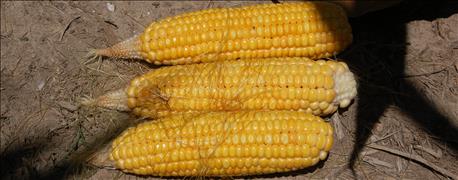
Is there value in walking through cornfields before harvest, counting ears and checking number of kernels per ear, all so you can get a yield estimate before harvest? Bryan Overstreet, Purdue Extension ag educator in Jasper County and an Indiana Certified Crop Adviser, says there are ways to use this information.
“You can use it to help with marketing,” he notes. In other words, yield estimation may help you zero in on how many bushels you should have either to forward-price contract or to market in some other way.
“It could also help with planning on drying cost,” he adds. And it should give you a better idea of what your storage needs will be this fall.

KERNEL SIZE MATTERS: Which "fudge factor" you plug into the yield estimation formula for kernel size makes a big difference on estimated yield. Kernel size can be hard to nail down correctly.
“Finding a yield range is more practical than trying to dial in on a single number,” says Jamie Bultemeier, an agronomist for A&L Great Lakes Labs, Fort Wayne, and also a CCA. “Ask yourself why you are estimating yield. If you’re looking to market grain, use the low end of the range [of estimates] so that you don’t oversell ahead of harvest.
“If you’re looking to ensure you have enough storage capacity, maybe using the large end of the yield range will reduce your risk.”
Kernel size factor
You can count ears, number of rows per ear and number of kernels per row. Those are reasonably objective numbers. The tougher number to measure is kernel size. It is the "fudge factor" in the yield estimation formula commonly used, and perhaps why a range is more practical than a single number for estimating yields.
The three common fudge factors that take into account kernel size are 75, 85 and 95. “These are all variable numbers that will depend upon kernel weight, size and density,” says Gene Flaningam, Vincennes, also a CCA. “The higher the final number that you use, the lower your yield calculation will be. I have found my yield estimates to be low compared to actual harvest numbers in the last two growing seasons.”
Here is a three-step example that illustrates how much kernel size can impact a yield estimate. In each example, everything is constant except the fudge factor. It’s based on kernel size, largely determined by weather factors in the latter part of the growing season.
Example 1. You find 30 ears per 1/1000 acre, with 16 rows per ear and 35 kernels per row. Use an average fudge factor for kernel size of 85.
The math: 30 x (16 x 35) = 16,800 / 85 = 197.7 bushels per acre
Example 2. The number of ears, rows of kernels per ear and number of kernels per row are the same. Due to dry weather in August, kernel size is reduced, so the fudge factor increases to 95.
The math: 30 x (16 x 35) = 16,800 / 95 = 176.9 bushels per acre
Example 3. The number of ears, rows of kernels per ear and number of kernels per row are the same. August weather is favorable and kernels are plumper than usual. Use the fudge factor of 75.
The math: 30 x (16 x 35) = 16,800 / 75 = 224 bushels per acre
Note that there is a swing of nearly 48 bushels per acre based on estimated kernel size alone.
About the Author(s)
You May Also Like




